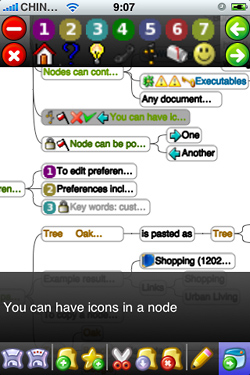 iFreeMind is a new app for the iPhone and iPod Touch platform that generates FreeMind-compatible mind maps. FreeMind is an open-source mind mapping program for windows, Mac OS X and Linux. Read on to learn more about the strengths – and the shortcomings – of this app.
iFreeMind is a new app for the iPhone and iPod Touch platform that generates FreeMind-compatible mind maps. FreeMind is an open-source mind mapping program for windows, Mac OS X and Linux. Read on to learn more about the strengths – and the shortcomings – of this app.
iFreeMind offers the following features:
- Files may be imported and exported utilizing the program’s built-in web management service
- Attachment of icons to map topics
- The ability to view your maps in portrait or landscape mode.
- Maps of up to 150 topics are supported, at a maximum size of 1400 x 1400 pixels.
- Topic text can be up to 200 words long, and a single topic node may contain up to 5 icons – pretty generous!
- Triple tapping the workspace moves the map to the center of the screen, which may be very useful when working with large maps.
- Double-tapping the editing screen displays the program’s toolbar.
- Tapping a topic once to select it displays its full text in a rectangular area between the workspace and the bottom toolbar. Since topic text can be very lengthy (up to 200 words in iFreeMind), the program truncates the topic text in the map itself to save on screen real estate, but displays its entire contents in this area.
- Holding down a toolbar button for more than one second causes a tool tip pop-up that explains what it does – nice!
- Uploading and downloading of maps between the iPhone and a PC or Mac: Within iFreeMind, you tap the web file manager button, which causes a URL to be displayed at the top of the screen. Next, you open a browser on your Mac or PC, and input this URL. This takes you to a file management page, where you can upload and download FreeMind-formatted map files.
What’s missing from iFreeMind:
- Support for topic links and notes – these are critical, and are conspicuous by their absence in iFreeMind
- No ability to freely position map topics using drag and drop (iBlueSky and SimpleMind can do this)
- No ability to drag and drop topics from one location within your map to another (SimpleMind currently supports this capability). In order to move a map topic, you must cut it, select the topic to which you want it to be attached as a sub-topic, and then paste it.
Ideally, the mind mapping app should be usable as soon as it is installed on your iPhone, without having to refer to a help file or the developer’s web page. Several of the existing mind mapping apps for the iPhone and iPod Touch certainly fit this description. Unfortunately, in my opinion, iFreeMind does not. When I first open the program and tried to create a simple mind map, I couldn’t figure out several of the toolbar buttons; they just aren’t very intuitive. I struggled to figure out how to get the program to do what I wanted it to do, and finally proceeded via trial and error to create my first map.
Like other computing platforms, the iPhone and iPod touch market is becoming crowded with many “me too” mind mapping applications. If you’re a relatively late entrant to the field, which iFreeMind is, you’d better be prepared to differentiate your app. While iFreeMind’s native support for FreeMind files is an advantage, especially if you have created a lot of maps using this desktop tool, it’s not enough for me to recommend iFreeMind to you. The user interface is just too confusing and cluttered for first-time users, and the lack of support for drag and drop means rearranging your map topics will quickly become an exercise in futility. Finally, without the support for notes and links, you’re really limited in the types of maps you can produce in iFreeMind.
One of my fellow bloggers, Vic Gee, calls iFreeMind “a serious challenger to existing iPhone mind mapping apps” but I disagree. In my opinion, iFreeMind, in its current configuration, doesn’t measure up to its competition.
iFreeMind is available for download from the Apple AppStore for US $4.99. For more details about this new mind mapping app, please visit the developer’s web page.

Leave a Reply